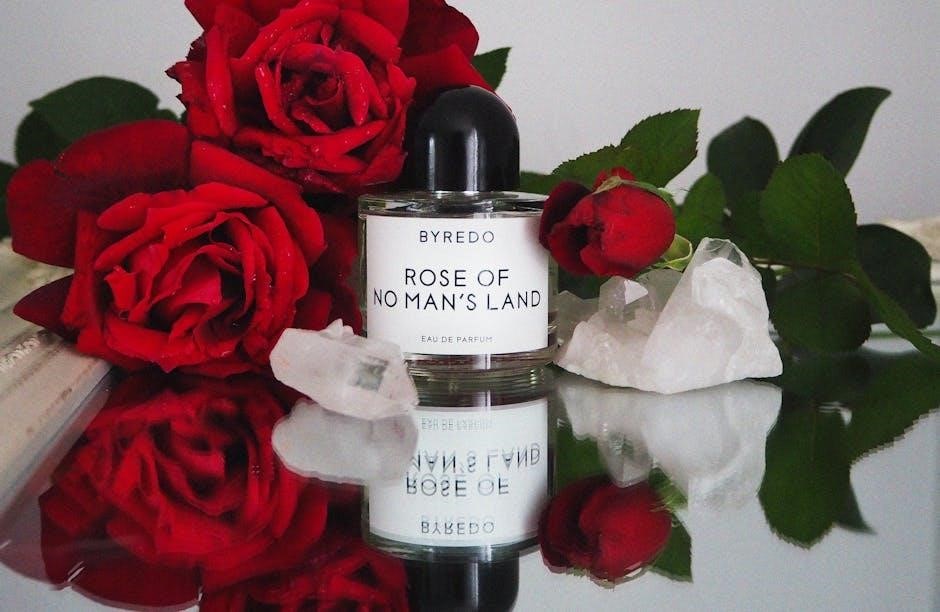perfume notes guide
Perfume notes are the essence of a fragrance, divided into top, middle, and base notes. They create a scent’s unique character, evolving over time. Understanding these notes helps in selecting fragrances that align with personal preferences, ensuring a lasting impression.
Understanding Top Notes
Top notes are the initial scents perceived when a fragrance is applied, creating the first impression. They are typically light, fresh, and fleeting, lasting only a few minutes. These notes are designed to immediately captivate the senses, setting the tone for the rest of the fragrance. Common examples include citrus, mint, and bergamot, which provide a crisp, invigorating quality. Top notes are usually volatile molecules that evaporate quickly, making them the most transient part of the fragrance pyramid.
The purpose of top notes is to draw attention and create an emotional connection. They often dictate whether someone is initially drawn to a perfume. However, their brief duration means they don’t linger long, paving the way for the middle notes to emerge. Understanding top notes can help you identify fragrances that align with your preferences, whether you prefer bold and energetic or soft and delicate. By focusing on these opening scents, you can better navigate the world of perfumery and make informed choices when selecting a fragrance. Top notes are the gateway to a perfume’s unique character, making them a crucial element in the fragrance experience.
Exploring Middle Notes
Middle notes, often referred to as heart notes, emerge after the top notes fade, typically within 15 to 30 minutes of application. These notes form the core of a fragrance, providing depth and complexity. They are often floral, spicy, or fruity, creating a harmonious bridge between the initial top notes and the lingering base notes. Middle notes are essential for balancing a fragrance, ensuring it doesn’t feel too harsh or overpowering. Their presence defines the character of the scent, making them a critical component in the fragrance pyramid.
Floral scents like rose, jasmine, and lavender are common middle notes, adding softness and warmth. Spices such as cinnamon, cardamom, and nutmeg can also dominate this stage, introducing a sense of sophistication. Fruity notes like berries or citrus may appear, offering a refreshing contrast. The middle notes are responsible for the fragrance’s emotional appeal, making it more personal and evocative. They also prepare the skin for the base notes, ensuring a smooth transition. Understanding middle notes helps in appreciating how a fragrance evolves and settles on the skin, making them a key element in perfume appreciation.
Discovering Base Notes
Base notes are the final and longest-lasting layer in a fragrance, emerging after the middle notes have faded. They typically appear within 30 minutes to an hour after application and can linger on the skin for several hours. These notes are rich, deep, and grounding, providing warmth and complexity to the scent. Common base note ingredients include woods (like cedarwood and sandalwood), resins (such as amber and myrrh), musks, vanilla, and patchouli. These elements add depth and longevity to the fragrance, ensuring it doesn’t disappear quickly. Base notes are responsible for the “dry down” of a perfume, leaving a lasting impression that ties the entire composition together.
The base notes are often associated with emotions and memories, as they linger longest on the skin. They can evoke feelings of comfort, sensuality, or sophistication, depending on the ingredients used. Understanding base notes helps perfume enthusiasts appreciate the final stage of a fragrance’s evolution, making them a crucial part of the perfume experience. By identifying these notes, one can better navigate fragrance preferences and appreciate the artistry behind scent creation.
How to Identify Fragrance Families
Fragrance families are categories that group perfumes based on their dominant notes and overall scent profile. Identifying these families helps in understanding and selecting fragrances that suit personal preferences. The main fragrance families include floral, citrus, woody, oriental, fresh, and gourmand. Each family has distinct characteristics: floral fragrances emphasize flower notes, while citrus scents are bright and zesty. Woody fragrances feature earthy and aromatic notes like cedar or sandalwood, while oriental scents are rich and warm, often incorporating spices, amber, and vanilla. Fresh fragrances are light and airy, often with green or aquatic notes, and gourmand scents mimic edible treats like chocolate or fruits.
To identify a fragrance family, pay attention to the dominant notes and the overall impression the scent leaves. Floral fragrances are typically feminine and elegant, while woody and oriental scents are often deeper and more complex. Citrus and fresh fragrances are ideal for everyday wear, offering a invigorating and uplifting experience. Understanding these families simplifies the process of exploring perfumes and finding one that resonates with your taste.
Guide to Fragrance Strengths
Fragrance strengths refer to the concentration of essential oils in a perfume, which determines its longevity and intensity. The most common strengths are parfum, ‘eau de parfum (EDP), ‘eau de toilette (EDT), ‘eau de cologne (EDC), and ‘eau fraîche. Parfum, the strongest, contains 15-30% essential oils and lasts up to 8 hours. EDP has 10-20% and lasts 4-6 hours, making it a popular choice for everyday use. EDT, with 5-15% concentration, is lighter and suitable for casual wear, lasting 2-4 hours. EDC is even lighter, with 3-5% essential oils, and is often used for fresh, citrus-based scents. Eau fraîche is the lightest, containing 1-3% essential oils and lasting 1-2 hours, ideal for delicate preferences.
Understanding fragrance strengths helps in selecting the right scent for different occasions. Stronger concentrations like parfum and EDP are perfect for evening events or special occasions, while lighter options like EDT and eau fraîche are better suited for daytime or office wear. The choice depends on personal preference, lifestyle, and the desired longevity of the fragrance.

Top Tips for Testing Perfumes
Testing perfumes effectively requires patience and a systematic approach. Always spray the fragrance on your skin, as perfumes interact differently with each individual’s chemistry. Apply it to an unscented, moisturized area, such as the inside of your wrist or behind the ear, to ensure a neutral base. Allow the scent to settle for at least 15-30 minutes to experience the full evolution of top, middle, and base notes.
- Avoid testing multiple fragrances in one session to prevent olfactory fatigue. Limit yourself to 3-4 scents at a time.
- Use an unscented lotion or oil on the area before applying perfume to enhance longevity and projection.
- Test fragrances on a “scent-free” day, avoiding strong foods, coffee, or other perfumes that could interfere.
- Reapply the fragrance after 30 minutes to assess its true character and longevity.
Remember, the way a perfume smells on a strip is different from how it smells on your skin. Give it time to unfold and note how it makes you feel. This approach ensures a genuine connection with the fragrance.
Building Your Fragrance Wardrobe
Curating a fragrance wardrobe involves selecting scents that reflect your personality, lifestyle, and preferences. Start by identifying a signature fragrance that embodies your identity, then expand your collection to include options for different occasions and seasons; Consider versatile scents that can transition seamlessly from day to night or season to season.
- Begin with a signature scent that aligns with your personal style and emotions.
- Incorporate seasonal fragrances, such as lighter citrus notes for summer and richer, spicy scents for winter.
- Experiment with fragrance concentrations, like eau de cologne for everyday use and parfum for special occasions.
- Use a fragrance wheel to discover new scents based on your preferences.
Don’t be afraid to layer fragrances or explore niche and designer brands to diversify your wardrobe. Seek recommendations from experts or friends to uncover hidden gems. Remember, your fragrance wardrobe is a personal journey, so invest in scents that bring you joy and confidence.
Using Fragrance Wheels Effectively
A fragrance wheel is a valuable tool for navigating the complex world of perfumery. It organizes scents into categories, such as floral, citrus, woody, and oriental, helping you identify patterns and relationships between notes. By understanding how fragrances are grouped, you can explore new scents with confidence.
- Start by identifying your preferred fragrance family to find similar scents.
- Use the wheel to discover complementary notes and broaden your horizons.
- Pay attention to how scents evolve over time, as this reflects their top, middle, and base notes.
- Leverage the wheel to layer fragrances effectively for a unique, personalized scent.
Whether you’re a novice or an enthusiast, a fragrance wheel simplifies the process of selecting and combining perfumes. It’s a practical guide to exploring the world of fragrance with clarity and precision.
The Role of a Perfumer
A perfumer is the creator behind the art of fragrance, blending artistry with scientific precision. Trained to identify and balance scent components, perfumers craft unique fragrances by combining essential oils, aroma compounds, and other ingredients. Their expertise lies in understanding how notes evolve over time, ensuring each fragrance tells a story.
The perfumer’s process begins with envisioning the character of the scent, selecting ingredients, and testing the blend. They adjust proportions to achieve harmony, considering how top, middle, and base notes interact. This requires a deep understanding of fragrance families and trends. Perfumers also face challenges like sustainability and allergies, driving innovation in ingredient sourcing and synthesis.
Perfumers are not just technicians; they are artists who evoke emotions and memories. Their work is invisible yet powerful, shaping how we experience scent in everyday life. Whether creating for luxury brands or niche houses, perfumers leave an indelible mark on the world of fragrance. Their craft is a testament to the transformative power of smell.

Sustainability in Perfume Production
Sustainability in perfume production is a growing focus, as the industry seeks to reduce its environmental footprint. Perfume creators are increasingly adopting eco-friendly practices, such as sourcing ingredients responsibly and minimizing waste. Many brands now prioritize organic and fair-trade materials, ensuring ethical labor practices and preserving biodiversity.
The use of synthetic fragrance components is also being explored to reduce reliance on rare natural resources. Additionally, eco-conscious packaging is becoming more prevalent, with recyclable and biodegradable materials replacing traditional plastics. Innovations in production processes aim to lower carbon emissions and water usage, making the industry more sustainable.
Consumers are driving demand for transparency, pushing brands to disclose ingredient origins and environmental policies. Certifications like “Cruelty-Free” and “Vegan” are gaining traction, aligning with broader sustainability goals. As awareness grows, the perfume industry continues to evolve, balancing creativity with responsibility to create fragrances that are both alluring and environmentally conscious.
Common Fragrance Myths Debunked
Several myths surround the world of perfumery, often leading to misunderstandings about how fragrances work. One common myth is that expensive perfumes are always superior in quality. While luxury brands may use rare ingredients, affordability does not necessarily equate to lower quality. Another myth is that perfume should only be applied to pulse points, but it can also be applied to clothing or hair for longevity.
Some believe that fragrances should be stored in refrigerators to preserve them, but cool, dark places are sufficient. Additionally, the idea that a fragrance smells the same on everyone is inaccurate, as skin chemistry plays a significant role in how a scent evolves. Debunking these myths helps consumers make informed choices and enjoy their fragrances more effectively.
Understanding these misconceptions fosters a better appreciation for the art of perfumery and encourages experimentation to find the perfect scent. By separating fact from fiction, perfume enthusiasts can navigate the world of fragrances with confidence and clarity.
Seasonal Fragrance Selection
Selecting fragrances based on the season can elevate your scent experience. Spring and summer call for lighter, fresher notes like citrus, floral, and green scents, which evoke vibrancy and clarity. Autumn and winter, however, are ideal for richer, warmer fragrances with spicy, woody, or oriental notes, offering comfort and depth.
Cooler weather often pairs well with robust base notes such as amber, vanilla, and musk, while warmer months highlight top notes like bergamot and grapefruit. Layering lighter fragrances in summer and switching to denser ones in winter can create a harmonious connection with the environment. Experimenting with seasonal scents allows for a dynamic wardrobe of fragrances tailored to each time of year.
By aligning your perfume choices with the seasons, you can enhance the sensory experience and enjoy your fragrances more fully, making each time of year feel unique and memorable.

Layering Fragrances for Depth
Layering fragrances is a sophisticated technique to create a unique and complex scent profile. By combining different fragrances, you can craft a personalized aroma that evolves throughout the day. Start with a base fragrance, such as a rich body lotion or oil, and add a complementary perfume on top. This method enhances longevity and depth, allowing each note to shine.
Experiment with pairing top, middle, and base notes from different scents. For example, layering a citrus fragrance over a woody base can create a harmonious blend. Pay attention to the strength of each fragrance to avoid overpowering the combination. Light, subtle scents work well as accents, while richer fragrances provide a foundation.
When layering, apply each fragrance to different pulse points and allow time for the scents to meld. This technique not only personalizes your fragrance experience but also adds dimension to your scent wardrobe. Remember, the key to successful layering is balance and experimentation.

Fragrance and Skin Chemistry
Fragrance and skin chemistry are deeply interconnected, as the way a perfume smells on you is uniquely influenced by your skin. Skin pH, natural oils, and even diet can alter how fragrance notes unfold. This personal interaction explains why the same perfume can smell different on various individuals.
When applied, the top notes of a fragrance are the first to emerge, but they quickly evolve based on skin chemistry. Oily skin tends to retain scents longer, while dry skin may cause fragrances to fade more rapidly. Additionally, factors like stress, hormones, and even the time of day can influence how your skin reacts to a perfume.
The longevity and projection of a fragrance are also affected by skin type. For instance, perfumes with heavy base notes, such as amber or musk, often perform well on skin with higher oil content. Conversely, lighter, citrus-based fragrances may be more suitable for drier skin types.
Understanding your skin’s chemistry can help you choose fragrances that complement your natural scent. Testing perfumes on your skin and allowing them to settle is essential, as the initial spray may not reflect how the fragrance will develop over time.
Vintage vs. Modern Fragrances
Vintage and modern fragrances differ significantly in their composition, character, and appeal. Vintage perfumes, often crafted in the early 20th century, are known for their rich, complex blends of natural ingredients like amber, musk, and floral absolutes. These scents were bold, longevity-focused, and often featured deep base notes that lingered for hours.
In contrast, modern fragrances tend to be lighter, fresher, and more versatile. They frequently incorporate synthetic molecules, which offer unique olfactive qualities and stability. Modern perfumes also cater to current trends, such as clean, unisex, and niche scents, often emphasizing top and middle notes for immediate appeal.
The shift from vintage to modern is partly due to changing tastes and regulatory restrictions on certain ingredients. Vintage fragrances often feel opulent and timeless, while modern ones are dynamic and innovative. Whether you prefer the classic elegance of vintage scents or the contemporary flair of modern ones, understanding their differences can help you appreciate their unique charm.
Ultimately, the choice between vintage and modern fragrances comes down to personal preference and the occasion. Both eras offer unforgettable creations, each with its own story and allure.

Perfume Concentration Guide
Perfume concentration refers to the strength and longevity of a fragrance, determined by the ratio of essential oils to alcohol and water. Higher concentrations mean more fragrance oil, resulting in a stronger scent and longer-lasting wear.
The most common concentrations are parfum (15-30% essential oils), eau de parfum (10-15%), eau de toilette (5-15%), eau fraîche (1-3%), and parfum oil (15-30% without alcohol). Each concentration offers a different intensity and duration, catering to various preferences and occasions.
Choosing the right concentration depends on personal taste, lifestyle, and the time of day. For example, eau de toilette is ideal for everyday use, while parfum is better for special events due to its richness and longevity. Understanding these differences helps in selecting the perfect fragrance strength to suit your needs.
Higher concentrations are generally more expensive but provide a more immersive experience. Lower concentrations are lighter and more versatile, making them suitable for office or casual settings. Experimenting with different strengths can help you find the one that best complements your personality and lifestyle.
Fragrance Families Explained
Fragrance families are categories that group perfumes based on their dominant notes and scent characteristics. These families help classify fragrances into recognizable groups, making it easier to identify personal preferences. The main fragrance families include floral, citrus, woody, oriental, fresh, gourmand, and chypre.
The floral family features scents like rose, jasmine, and lavender, creating soft, delicate aromas. Citrus fragrances, such as lemon and bergamot, are bright and uplifting. Woody scents, including cedarwood and sandalwood, offer earthy, grounding notes. The oriental family combines spices, amber, and vanilla for warm, rich fragrances.
Fresh fragrances often include aquatic or green notes, providing a clean, airy sensation. Gourmand scents are edible-inspired, with notes like chocolate and caramel. Chypre fragrances blend moss, patchouli, and citrus for a sophisticated, earthy aroma.
Understanding fragrance families simplifies the process of exploring perfumes. By identifying the families you gravitate toward, you can discover new fragrances with similar characteristics. This classification system also helps perfumers create balanced and harmonious scents, ensuring each fragrance tells a unique story.
Discovering your signature scent is a personal journey that combines exploration, intuition, and patience. By understanding perfume notes, fragrance families, and how scents evolve on your skin, you can navigate the vast world of perfumery with confidence. Start by identifying the notes and families that resonate with you, whether it’s the brightness of citrus, the warmth of orientals, or the freshness of aquatic scents.
Test fragrances on your skin, as scent chemistry varies from person to person. Allow the perfume to unfold—top notes for the first impression, middle notes for depth, and base notes for longevity. Consider your lifestyle and preferences: a delicate floral for everyday wear or a bold gourmand for special occasions.
Seasonal changes also play a role; lighter fragrances for summer and richer ones for winter. Experiment with layering or exploring niche and vintage perfumes for unique touches. Use tools like fragrance wheels and reviews to guide your search but trust your instincts above all.
Your signature scent is more than a fragrance—it’s a reflection of your personality and style. Embrace the journey, and when you find “the one,” it will feel like home.